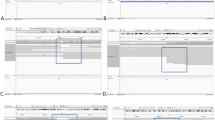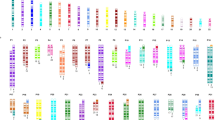Abstract
To test the hypothesis that translocation breakpoints in normal individuals are simple and do not disrupt genes, we characterised the breakpoints in 13 phenotypically normal individuals incidentally ascertained with an apparently balanced reciprocal translocation. Cases were karyotyped, and the breakpoints were refined by fluorescence in situ hybridisation until breakpoint-spanning clones were identified. 1 Mb array-CGH was performed as a whole genome analysis tool to detect any imbalances in chromatin not directly involved in the breakpoints. Breakpoint-associated imbalances were not found in any of the patients analysed in this study. However, breakpoints which disrupted known genes were identified in two patients, with RYR2 disrupted in one patient and COL13A1 in the other. In a further eight patients, Ensembl mapping data suggested that a gene might be disrupted by a breakpoint. In one further patient, the translocation was shown to be nonreciprocal. This study shows that apparently balanced reciprocal translocations in phenotypically normal patients do not have imbalances at the breakpoints, in contrast to phenotypically abnormal patients where the translocation breakpoints are often associated with cryptic imbalances. However, phenotypically normal individuals, and phenotypically abnormal individuals may have genes disrupted and therefore inactivated by one of the breakpoints. The significance of these disruptions remains to be determined.
Similar content being viewed by others
Log in or create a free account to read this content
Gain free access to this article, as well as selected content from this journal and more on nature.com
or
References
Jacobs PA, Browne C, Gregson N, Joyce C, White H : Estimates of the frequency of chromosome abnormalities detectable in unselected newborns using moderate levels of banding. J Med Genet 1992; 29: 103–108.
Gardner RJM, Sutherland GR : Chromosome Abnormalities and Genetic Counseling, 3rd ed Oxford: Oxford University Press, 2004; pp 36–59.
Warburton D : De novo balanced chromosome rearrangements and extra marker chromosomes identified at prenatal diagnosis: clinical significance and distribution of breakpoints. Am J Hum Genet 1991; 49: 995–1013.
Wirth J, Nothwang HG, van der Maarel S et al: Systematic characterisation of disease associated balanced chromosome rearrangements by FISH: cytogenetically and genetically anchored YACs identify microdeletions and candidate regions for mental retardation genes. J Med Genet 1999; 36: 271–278.
Astbury C, Christ LA, Aughton DJ et al: Detection of deletions in de novo ‘balanced’ chromosome rearrangements: further evidence for their role in phenotypic abnormalities. Genet Med 2004; 6: 81–89.
Gribble SM, Prigmore E, Burford DC et al: The complex nature of constitutional de novo apparently balanced translocations in patients presenting with abnormal phenotypes. J Med Genet 2005; 42: 8–16.
Giacalone JP, Francke U : Common sequence motifs at the rearrangement sites of a constitutional X/autosome translocation and associated deletion. Am J Hum Genet 1992; 50: 725–741.
Fiegler H, Carr P, Douglas EJ et al: DNA microarrays for comparative genomic hybridization based on DOP-PCR amplification of BAC and PAC clones. Genes Chromosomes Cancer 2003; 36: 361–374.
Franzini-Armstrong C, Protasi F : Ryanodine receptors of striated muscles: a complex channel capable of multiple interactions. Physiol Rev 1997; 77: 699–729.
Priori SG, Napolitano C, Tiso N et al: Mutations in the cardiac ryanodine receptor gene (hRyR2) underlie catecholaminergic polymorphic ventricular tachycardia. Circulation 2001; 103: 196–200.
Laitinen PJ, Brown KM, Piippo K et al: Mutations of the cardiac ryanodine receptor (RyR2) gene in familial polymorphic ventricular tachycardia. Circulation 2001; 103: 485–490.
Tiso N, Stephan DA, Nava A et al: Identification of mutations in the cardiac ryanodine receptor gene in families affected with arrhythmogenic right ventricular cardiomyopathy type 2 (ARVD2). Hum Molec Genet 2001; 10: 189–194.
Takeshima H, Komazaki S, Hirose K, Nishi M, Noda T, Iino M : Embryonic lethality and abnormal cardiac myocytes in mice lacking ryanodine receptor type 2. EMBO J 1998; 17: 3309–3316.
Brillantes AM, Allen P, Takahashi T, Izumo S, Marks AR : Differences in cardiac calcium release channel (ryanodine receptor) expression in myocardium from patients with end-stage heart failure caused by ischemic versus dilated cardiomyopathy. Circ Res 1992; 71: 18–26.
Serpente P, Tumpel S, Ghyselinck NB et al: Direct crossregulation between retinoic acid receptor {beta} and Hox genes during hindbrain segmentation. Development 2005; 132: 503–513.
de The H, Marchio A, Tiollais P, Dejean A : A novel steroid thyroid hormone receptor-related gene inappropriately expressed in human hepatocellular carcinoma. Nature 1987; 330: 667–670.
Lotan R, Xu XC, Lippman SM et al: Suppression of retinoic acid receptor-beta in premalignant oral lesions and its up-regulation by isotretinoin. N Eng J Med 1995; 332: 1405–1410.
Kreczel W, Ghyselinck N, Samad TA et al: Impaired locomotion and dopamine signalling in retinoid receptor mutant mice. Science 1998; 279: 863–867.
Kvist AP, Latvanlehto A, Sund M et al: Lack of cytosolic and transmembrane domains of type XIII collagen results in progressive myopathy. Am J Pathol 2001; 159: 1581–1592.
Acknowledgements
We thank Sarah Beal and Vivienne Maloney for help with the preparation of probes for FISH, and NS Thomas for performing microsatellite analysis. JB was supported by the Wellcome Trust.
Author information
Authors and Affiliations
Corresponding author
Rights and permissions
About this article
Cite this article
Baptista, J., Prigmore, E., Gribble, S. et al. Molecular cytogenetic analyses of breakpoints in apparently balanced reciprocal translocations carried by phenotypically normal individuals. Eur J Hum Genet 13, 1205–1212 (2005). https://doi.org/10.1038/sj.ejhg.5201488
Received:
Revised:
Accepted:
Published:
Issue date:
DOI: https://doi.org/10.1038/sj.ejhg.5201488
Keywords
This article is cited by
-
The relationship between genome structure and function
Nature Reviews Genetics (2021)
-
Prediction of a rare chromosomal aberration simultaneously with next generation sequencing-based comprehensive chromosome screening in human preimplantation embryos for recurrent pregnancy loss
Journal of Assisted Reproduction and Genetics (2018)
-
Balanced into array: genome-wide array analysis in 54 patients with an apparently balanced de novo chromosome rearrangement and a meta-analysis
European Journal of Human Genetics (2011)
-
Identification of cryptic imbalance in phenotypically normal and abnormal translocation carriers
European Journal of Human Genetics (2006)
-
Molecular genetic analysis of a de novo balanced translocation t(6;17)(p21.31;q11.2) associated with hypospadias and anorectal malformation
Human Genetics (2006)



